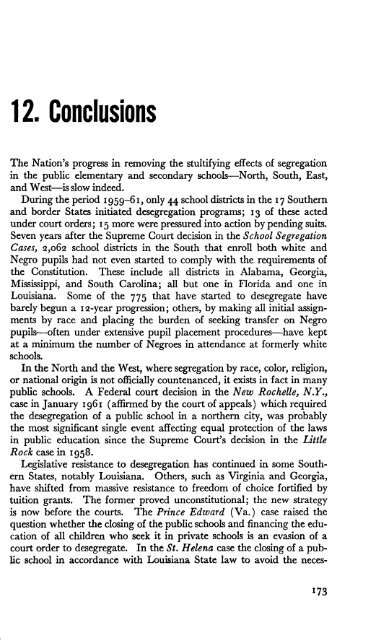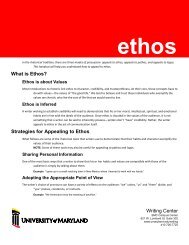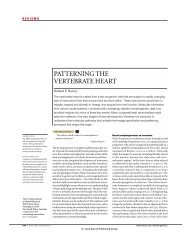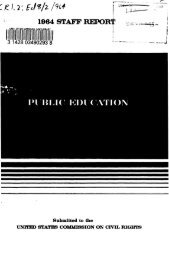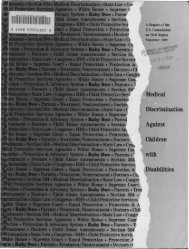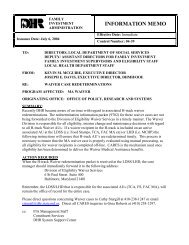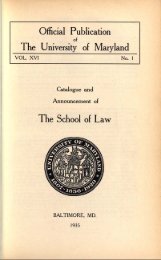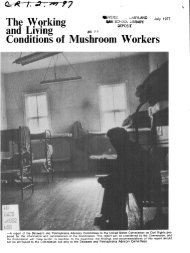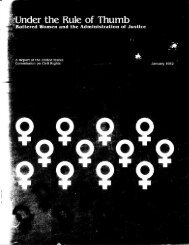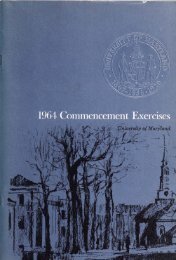1961 US Commission on Civil Rights Report Book 2 - University of ...
1961 US Commission on Civil Rights Report Book 2 - University of ...
1961 US Commission on Civil Rights Report Book 2 - University of ...
Create successful ePaper yourself
Turn your PDF publications into a flip-book with our unique Google optimized e-Paper software.
12. C<strong>on</strong>clusi<strong>on</strong>s<br />
The Nati<strong>on</strong>'s progress in removing the stultifying effects <strong>of</strong> segregati<strong>on</strong><br />
in the public elementary and sec<strong>on</strong>dary schools—North, South, East,<br />
and West—is slow indeed.<br />
During the period 1959-61, <strong>on</strong>ly 44 school districts in the 17 Southern<br />
and border States initiated desegregati<strong>on</strong> programs; 13 <strong>of</strong> these acted<br />
under court orders; 15 more were pressured into acti<strong>on</strong> by pending suits.<br />
Seven years after the Supreme Court decisi<strong>on</strong> in the School Segregati<strong>on</strong><br />
Cases, 2,062 school districts in the South that enroll both white and<br />
Negro pupils had not even started to comply with the requirements <strong>of</strong><br />
the C<strong>on</strong>stituti<strong>on</strong>. These include all districts in Alabama, Georgia,<br />
Mississippi, and South Carolina; all but <strong>on</strong>e in Florida and <strong>on</strong>e in<br />
Louisiana. Some <strong>of</strong> the 775 that have started to desegregate have<br />
barely begun a 12-year progressi<strong>on</strong>; others, by making all initial assignments<br />
by race and placing the burden <strong>of</strong> seeking transfer <strong>on</strong> Negro<br />
pupils—<strong>of</strong>ten under extensive pupil placement procedures—have kept<br />
at a minimum the number <strong>of</strong> Negroes in attendance at formerly white<br />
schools.<br />
In the North and the West, where segregati<strong>on</strong> by race, color, religi<strong>on</strong>,<br />
or nati<strong>on</strong>al origin is not <strong>of</strong>ficially countenanced, it exists in fact in many<br />
public schools. A Federal court decisi<strong>on</strong> in the New Rochelle, N.Y.,<br />
case in January <str<strong>on</strong>g>1961</str<strong>on</strong>g> (affirmed by the court <strong>of</strong> appeals) which required<br />
the desegregati<strong>on</strong> <strong>of</strong> a public school in a northern city, was probably<br />
the most significant single event affecting equal protecti<strong>on</strong> <strong>of</strong> the laws<br />
in public educati<strong>on</strong> since the Supreme Court's decisi<strong>on</strong> in the Little<br />
Rock casein 1958.<br />
Legislative resistance to desegregati<strong>on</strong> has c<strong>on</strong>tinued in some Southern<br />
States, notably Louisiana. Others, such as Virginia and Georgia,<br />
have shifted from massive resistance to freedom <strong>of</strong> choice fortified by<br />
tuiti<strong>on</strong> grants. The former proved unc<strong>on</strong>stituti<strong>on</strong>al; the new strategy<br />
is now before the courts. The Prince Edward (Va.) case raised the<br />
questi<strong>on</strong> whether the closing <strong>of</strong> the public schools and financing the educati<strong>on</strong><br />
<strong>of</strong> all children who seek it in private schools is an evasi<strong>on</strong> <strong>of</strong> a<br />
court order to desegregate. In the St. Helena case the closing <strong>of</strong> a public<br />
school in accordance with Louisiana State law to avoid the neces-<br />
173


